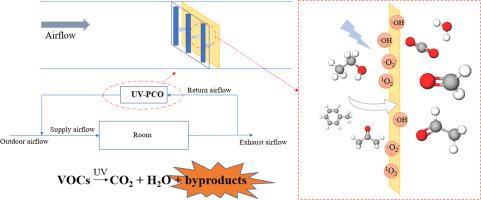Journal of Hazardous Materials ( IF 12.2 ) Pub Date : 2021-07-29 , DOI: 10.1016/j.jhazmat.2021.126766 Jing Wu 1 , Yousef Alipouri 1 , Hao Luo 1 , Lexuan Zhong 1

|
Photocatalytic oxidation (PCO)-based air filters are gaining attention owing to their capacity for indoor pollutant removal. This review summarized the application of ultraviolet-photocatalytic oxidation (UV-PCO) in heating, ventilation, and air conditioning (HVAC) systems, including the modeling studies, reactor designs, the influence of operational conditions, with emphasis on the common issue of byproduct generation, and the resulting indoor byproduct exposure levels. As a result, the concentrations of the typical byproducts for the most challenging pollutants were relatively low, except for the PCO of ethanol. Hence, UV-PCO is not recommended for buildings with high ethanol concentrations. Based on the formation of the formaldehyde, a new exposure-based evaluation standard for UV-PCO was developed to evaluate the feasibility of integrating UV-PCO reactors into an HVAC system. Then, applying the newly developed evaluation standard on a developed database (data size: 174) from the literature, 32.5% of the cases were identified as suitable for HVAC system applications in residential and commercial buildings, and all cases could be used for industrial buildings. Finally, a case study was conducted to develop a support vector machine (SVM) classification model with good accuracy, and challenging compound types, inlet concentrations, and air velocity were found to be the main parameters affecting the applicability of UV-PCO.
中文翻译:

用于去除室内挥发性有机化合物的紫外光催化氧化技术:特别关注副产物形成和建模的批判性评论
基于光催化氧化 (PCO) 的空气过滤器因其去除室内污染物的能力而受到关注。本综述总结了紫外光催化氧化 (UV-PCO) 在供暖、通风和空调 (HVAC) 系统中的应用,包括建模研究、反应器设计、操作条件的影响,重点是副产品的常见问题产生,以及由此产生的室内副产品暴露水平。因此,除了乙醇的 PCO 外,最具挑战性的污染物的典型副产品的浓度相对较低。因此,不建议将 UV-PCO 用于乙醇浓度高的建筑物。基于甲醛的形成,开发了一种新的基于暴露的 UV-PCO 评估标准,以评估将 UV-PCO 反应器集成到 HVAC 系统中的可行性。然后,将新开发的评估标准应用于文献中开发的数据库(数据大小:174),确定 32.5% 的案例适用于住宅和商业建筑的暖通空调系统应用,并且所有案例都可用于工业建筑. 最后,进行了案例研究以开发具有良好准确性的支持向量机 (SVM) 分类模型,发现具有挑战性的化合物类型、入口浓度和空气速度是影响 UV-PCO 适用性的主要参数。5%的案例被确定为适用于住宅和商业建筑的暖通空调系统应用,所有案例都可以用于工业建筑。最后,进行了案例研究以开发具有良好准确性的支持向量机 (SVM) 分类模型,发现具有挑战性的化合物类型、入口浓度和空气速度是影响 UV-PCO 适用性的主要参数。5%的案例被确定为适用于住宅和商业建筑的暖通空调系统应用,所有案例都可以用于工业建筑。最后,进行了案例研究以开发具有良好准确性的支持向量机 (SVM) 分类模型,发现具有挑战性的化合物类型、入口浓度和空气速度是影响 UV-PCO 适用性的主要参数。











































 京公网安备 11010802027423号
京公网安备 11010802027423号